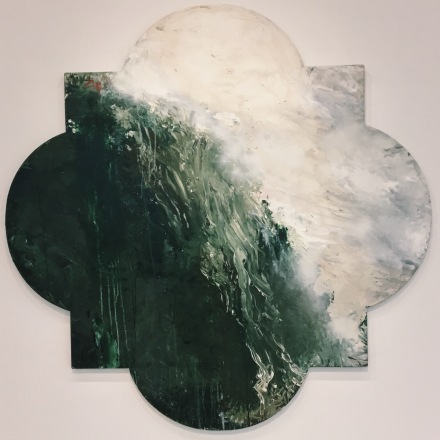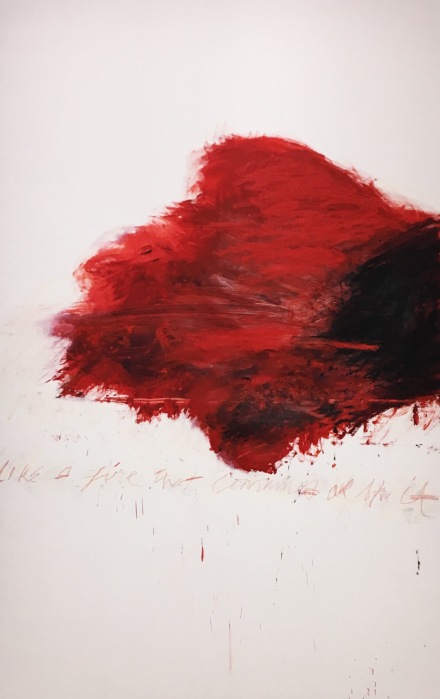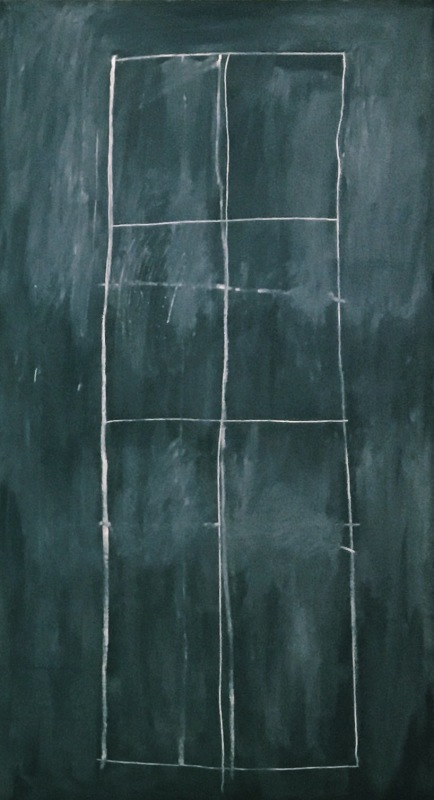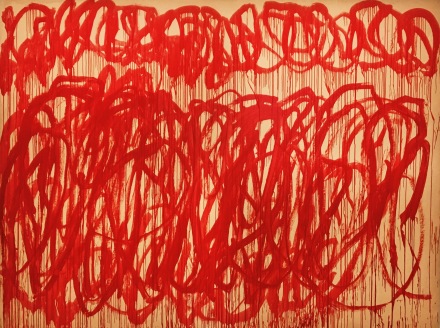
Cy Twombly, (Installation View), via Art Observed
The Centre Pompidou’s unique architectural layout gives itself over to the work of Cy Twombly this spring, spreading the artist’s work on a line of sight that parallels his pieces with the expansive cityscape of the French capital in Gallery 1.  The expansive retrospective, which has already earned major plaudits, unfolds gradually against this backdrop, offering a bold exploration of the artist’s impressive and influential canon.  The comprehensive collection of paintings, sculptures and photographs spans Twombly’s full career, highlighting his wide breadth of artistic styles, media and subject matter, while exploring the evolution and elaboration of his craft over the course of his career.

Cy Twombly, (Installation View), via Art Observed
With over 140 objects, this selection includes many of Twombly’s familiar bodies of work, some of which have never before gone on view in France.  Drawing on both thematic and chronological approaches to the artist’s work, the show is curated around three major cycles— Nine Discourses on Commodus (1963), Fifty Days at Iliam (1978) and his Coronation of Sesostris (2000) series. With many transitions and revisions, cycles and series are important to Twombly’s practice. From his early works in the 1950s that were influenced by ‘primitive’ art, street art and text, to his colorful and sensual compositions in the 1960s, to his response to American minimalism and conceptualism in the 1970s and his continued predilection for change, his practice is presented as highly aware of its own progressions, often returning to past forms or ideas in a pursuit of an ever-evolving and interrelated series of concepts.

Cy Twombly, (Installation View), via Art Observed
While the show presents developmental questions and welcomes observers to draw connections between each series, the show is also a celebration of identity and life of the artist in turn. Praised as one of the great painters of the twentieth century, Twombly was born in 1928 in Lexington, Virginia and died in 2011 in Rome.  Having chosen to spend most of his life in Italy, his work after the 1950s is greatly informed by his Mediterranean environment, drawing on both interests in the country’s landscape, culture, and the deepest reaches of its mythology, often delving into the intermingling of Roman and Greek mythology to inform his vivid style of painting.  Simultaneously merging elements from his life in America with his life in Europe, his art reflects a multi-faceted intellect merging the formal language of American abstract expressionism with the cultural history of his adopted home, presented here in all of its nuance.

Cy Twombly, (Installation View), via Art Observed
While his work suggests interplay between old and new perspectives, Twombly’s ties to the American South remained strong throughout the duration of his life.  In many ways, his body of work mediates the historical events that occurred during his career, contemplating the social and political changes taking place in both the U.S. and abroad. His work became more overtly reflective following the death of John F. Kennedy in 1963. Creating the series Nine Discourses on Commodus as a reaction to the American tragedy, he painted powerful canvases that are rooted in classical tales, taking a keen interest in color, that allows works to progress chronologically as if bold, fantastically vivid variations on a theme of loss and despair. Hung in one of the first rooms in the gallery space, these iconographically loaded images are brimming with sensational, somber emotion.

Cy Twombly, (Installation View), via Art Observed
As the exhibition progresses, attention to color, negative space, text and mark-making become more intentional, with a heightened sense of potency..  Set aside in a separate room from the sprawling main selection of pieces are works from Fifty Days at Iliam. Filled with a resigned energy equal to that of a sacred sanctuary, the works possess a kinetic vitality emphasized by the artist’s sweeping hand and rough-shod gesture, electrifying the canvas while offering moments of gentle repose. The rich tones and their contrast with the artist’s dynamic movement across space manage to feel both meticulous and immediate.

Cy Twombly, (Installation View), via Art Observed
Twombly’s oeuvre makes reference to myth, history and art while reinterpreting personal experience through an assertive sense of the abstract.  With stains, scribbles, drips and cuts, Twombly’s hand is present in the space, and delves deep into the act of painting.  Set alongside paintings and sculptures are early studies and still life photographs from his time at Black Mountain College, North Carolina. Drawing striking connections between the artist’s spare images and his deliberate, powerful brushstrokes, the show captures much of Twombly’s intuitive aesthetic sense, and captures the best elements of his work, simple moments spread out into a moment of spiritual rapture.
Cy Twombly’s retrospective is on view at The Centre Pompidou through April 24th, 2017.
— S. Ozer
Read more:
Cy Twombly at Centre Pompidou [The Centre Pompidou]



